MGT 712: Analyzing Health & Wellbeing Governance & Stakeholders
VerifiedAdded on 2023/06/03
|12
|3356
|401
Report
AI Summary
This report provides an analysis of Sustainable Development Goal 3 (SDG 3), focusing on health and wellbeing. It examines the governance structure supporting the goal, from the Division for Sustainable Development Goals (DSDG) to the World Health Organization (WHO), and identifies key stakeholders using Mitchell et al's stakeholder theory. The report also discusses the UN Principles for Responsible Management Education (PRME) and how corporations can contribute to achieving SDG 3 through research, partnership, and promoting healthy practices. Recommendations include corporate investment in research for nutritious food and wellness programs, forming partnerships, and implementing PRME principles to foster social responsibility and ethical business practices to improve global health outcomes.
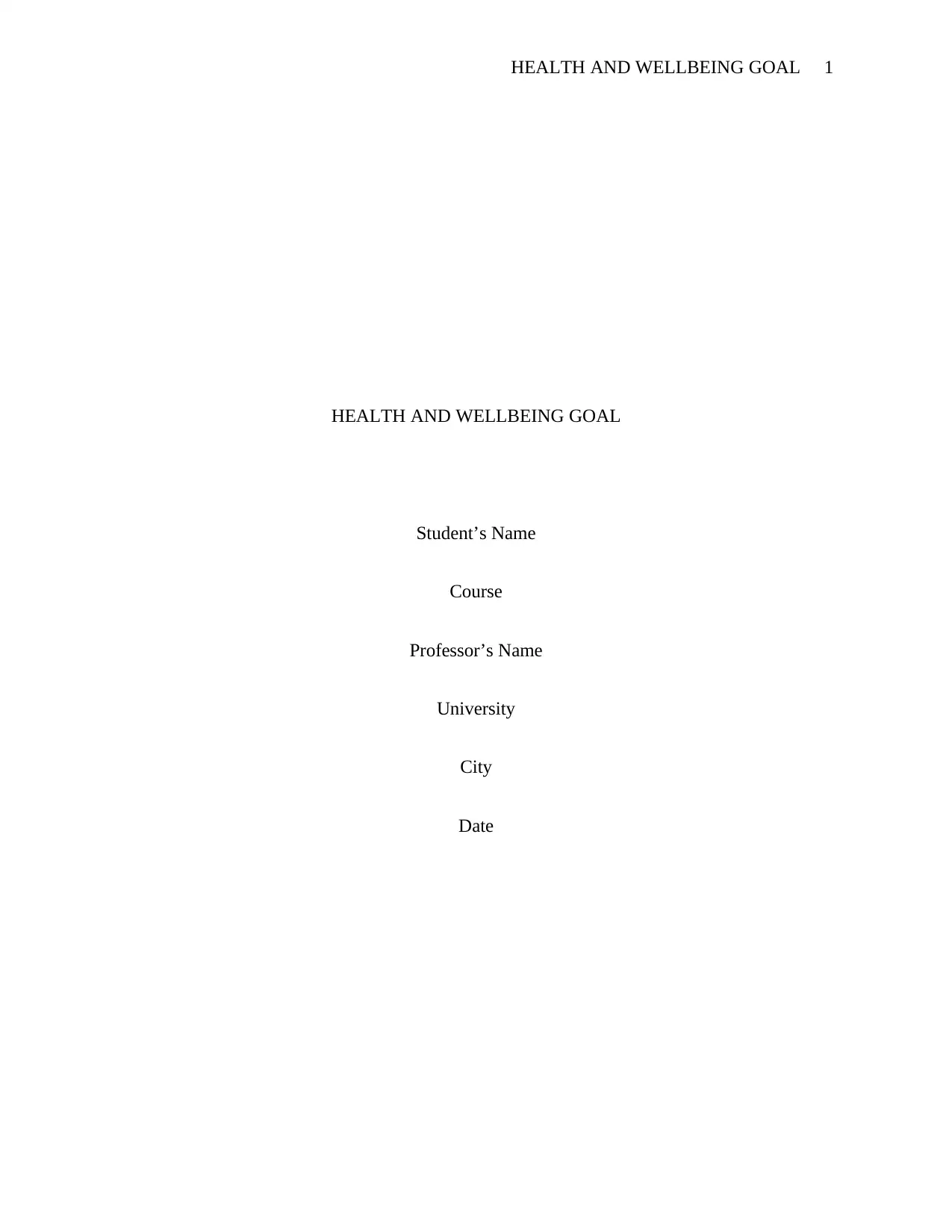
HEALTH AND WELLBEING GOAL 1
HEALTH AND WELLBEING GOAL
Student’s Name
Course
Professor’s Name
University
City
Date
HEALTH AND WELLBEING GOAL
Student’s Name
Course
Professor’s Name
University
City
Date
Paraphrase This Document
Need a fresh take? Get an instant paraphrase of this document with our AI Paraphraser
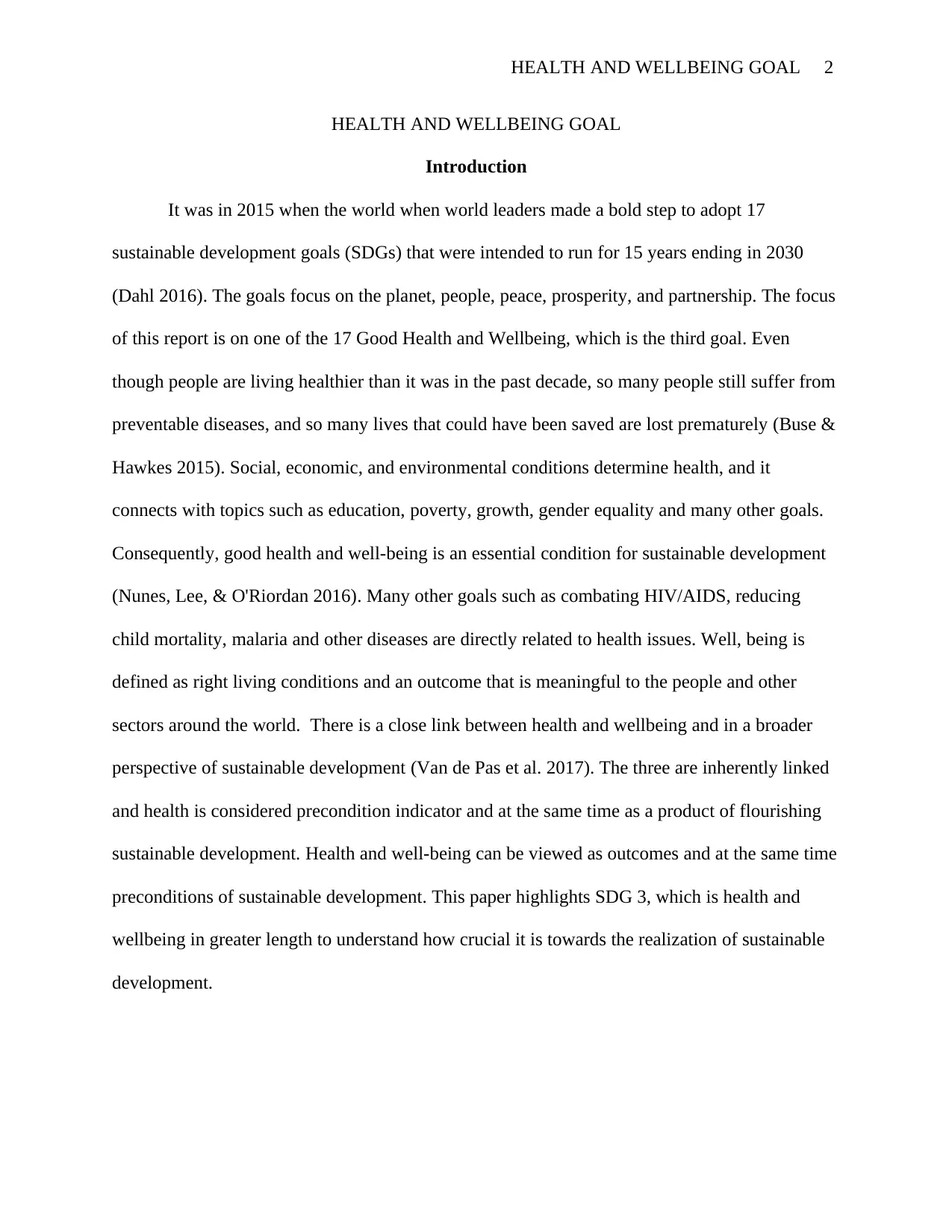
HEALTH AND WELLBEING GOAL 2
HEALTH AND WELLBEING GOAL
Introduction
It was in 2015 when the world when world leaders made a bold step to adopt 17
sustainable development goals (SDGs) that were intended to run for 15 years ending in 2030
(Dahl 2016). The goals focus on the planet, people, peace, prosperity, and partnership. The focus
of this report is on one of the 17 Good Health and Wellbeing, which is the third goal. Even
though people are living healthier than it was in the past decade, so many people still suffer from
preventable diseases, and so many lives that could have been saved are lost prematurely (Buse &
Hawkes 2015). Social, economic, and environmental conditions determine health, and it
connects with topics such as education, poverty, growth, gender equality and many other goals.
Consequently, good health and well-being is an essential condition for sustainable development
(Nunes, Lee, & O'Riordan 2016). Many other goals such as combating HIV/AIDS, reducing
child mortality, malaria and other diseases are directly related to health issues. Well, being is
defined as right living conditions and an outcome that is meaningful to the people and other
sectors around the world. There is a close link between health and wellbeing and in a broader
perspective of sustainable development (Van de Pas et al. 2017). The three are inherently linked
and health is considered precondition indicator and at the same time as a product of flourishing
sustainable development. Health and well-being can be viewed as outcomes and at the same time
preconditions of sustainable development. This paper highlights SDG 3, which is health and
wellbeing in greater length to understand how crucial it is towards the realization of sustainable
development.
HEALTH AND WELLBEING GOAL
Introduction
It was in 2015 when the world when world leaders made a bold step to adopt 17
sustainable development goals (SDGs) that were intended to run for 15 years ending in 2030
(Dahl 2016). The goals focus on the planet, people, peace, prosperity, and partnership. The focus
of this report is on one of the 17 Good Health and Wellbeing, which is the third goal. Even
though people are living healthier than it was in the past decade, so many people still suffer from
preventable diseases, and so many lives that could have been saved are lost prematurely (Buse &
Hawkes 2015). Social, economic, and environmental conditions determine health, and it
connects with topics such as education, poverty, growth, gender equality and many other goals.
Consequently, good health and well-being is an essential condition for sustainable development
(Nunes, Lee, & O'Riordan 2016). Many other goals such as combating HIV/AIDS, reducing
child mortality, malaria and other diseases are directly related to health issues. Well, being is
defined as right living conditions and an outcome that is meaningful to the people and other
sectors around the world. There is a close link between health and wellbeing and in a broader
perspective of sustainable development (Van de Pas et al. 2017). The three are inherently linked
and health is considered precondition indicator and at the same time as a product of flourishing
sustainable development. Health and well-being can be viewed as outcomes and at the same time
preconditions of sustainable development. This paper highlights SDG 3, which is health and
wellbeing in greater length to understand how crucial it is towards the realization of sustainable
development.
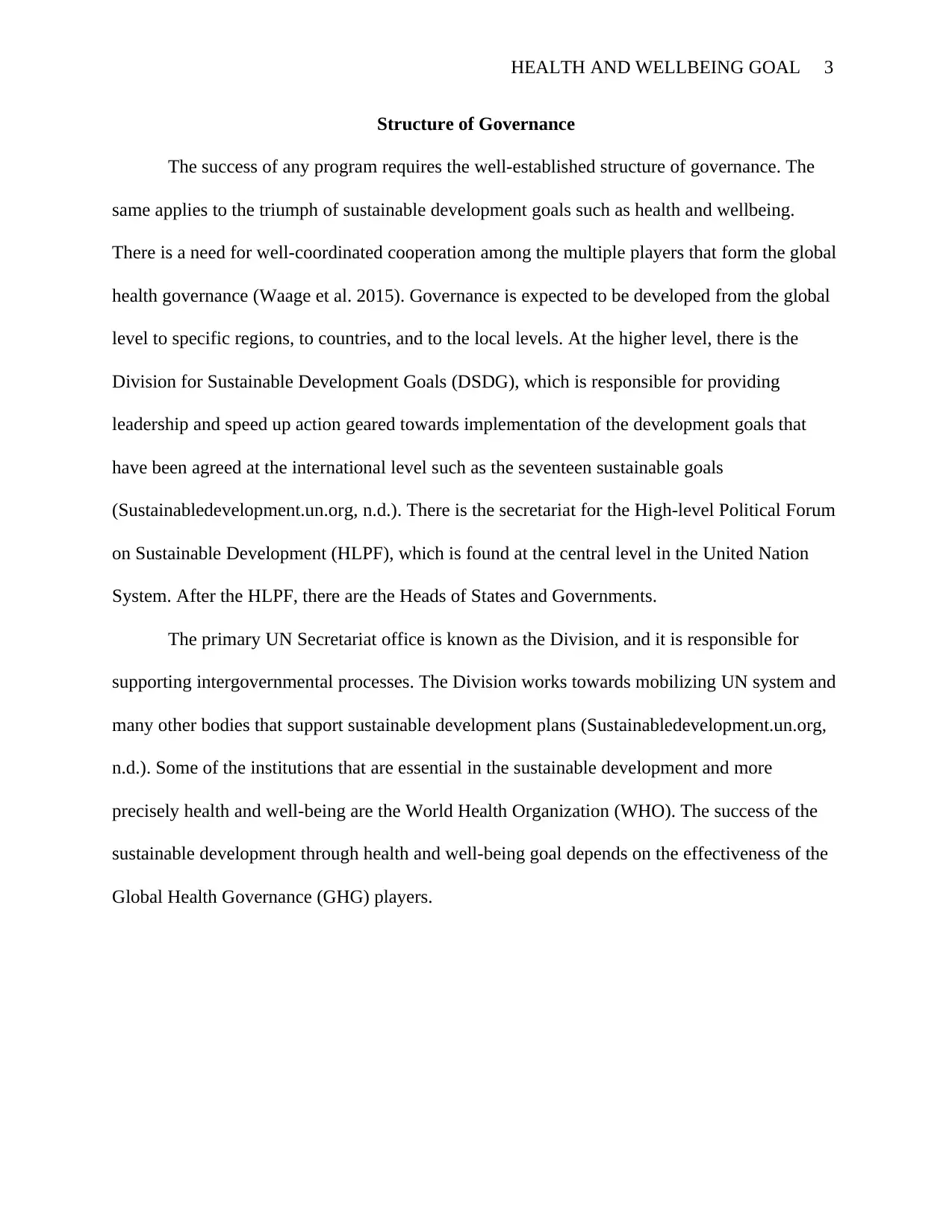
HEALTH AND WELLBEING GOAL 3
Structure of Governance
The success of any program requires the well-established structure of governance. The
same applies to the triumph of sustainable development goals such as health and wellbeing.
There is a need for well-coordinated cooperation among the multiple players that form the global
health governance (Waage et al. 2015). Governance is expected to be developed from the global
level to specific regions, to countries, and to the local levels. At the higher level, there is the
Division for Sustainable Development Goals (DSDG), which is responsible for providing
leadership and speed up action geared towards implementation of the development goals that
have been agreed at the international level such as the seventeen sustainable goals
(Sustainabledevelopment.un.org, n.d.). There is the secretariat for the High-level Political Forum
on Sustainable Development (HLPF), which is found at the central level in the United Nation
System. After the HLPF, there are the Heads of States and Governments.
The primary UN Secretariat office is known as the Division, and it is responsible for
supporting intergovernmental processes. The Division works towards mobilizing UN system and
many other bodies that support sustainable development plans (Sustainabledevelopment.un.org,
n.d.). Some of the institutions that are essential in the sustainable development and more
precisely health and well-being are the World Health Organization (WHO). The success of the
sustainable development through health and well-being goal depends on the effectiveness of the
Global Health Governance (GHG) players.
Structure of Governance
The success of any program requires the well-established structure of governance. The
same applies to the triumph of sustainable development goals such as health and wellbeing.
There is a need for well-coordinated cooperation among the multiple players that form the global
health governance (Waage et al. 2015). Governance is expected to be developed from the global
level to specific regions, to countries, and to the local levels. At the higher level, there is the
Division for Sustainable Development Goals (DSDG), which is responsible for providing
leadership and speed up action geared towards implementation of the development goals that
have been agreed at the international level such as the seventeen sustainable goals
(Sustainabledevelopment.un.org, n.d.). There is the secretariat for the High-level Political Forum
on Sustainable Development (HLPF), which is found at the central level in the United Nation
System. After the HLPF, there are the Heads of States and Governments.
The primary UN Secretariat office is known as the Division, and it is responsible for
supporting intergovernmental processes. The Division works towards mobilizing UN system and
many other bodies that support sustainable development plans (Sustainabledevelopment.un.org,
n.d.). Some of the institutions that are essential in the sustainable development and more
precisely health and well-being are the World Health Organization (WHO). The success of the
sustainable development through health and well-being goal depends on the effectiveness of the
Global Health Governance (GHG) players.
⊘ This is a preview!⊘
Do you want full access?
Subscribe today to unlock all pages.

Trusted by 1+ million students worldwide
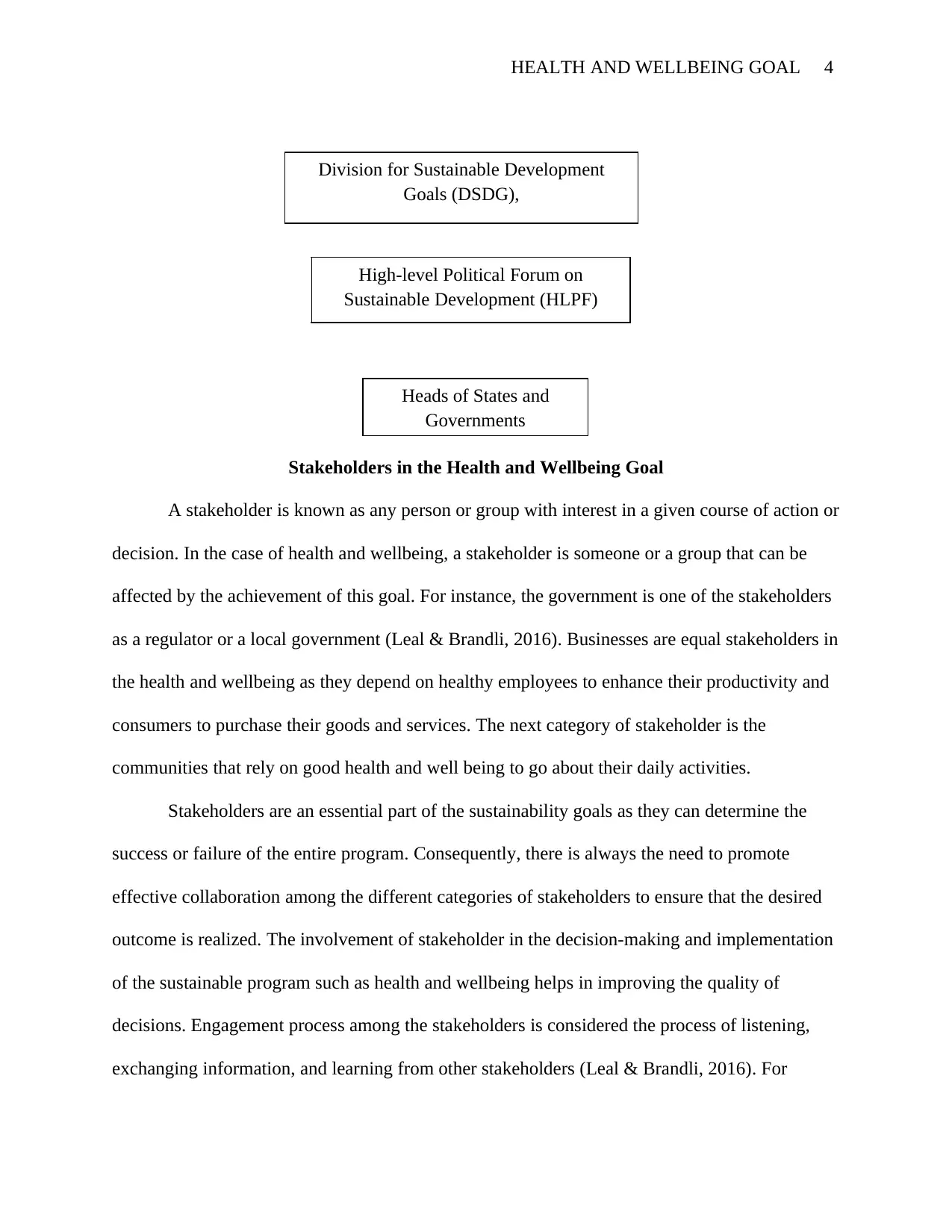
HEALTH AND WELLBEING GOAL 4
Stakeholders in the Health and Wellbeing Goal
A stakeholder is known as any person or group with interest in a given course of action or
decision. In the case of health and wellbeing, a stakeholder is someone or a group that can be
affected by the achievement of this goal. For instance, the government is one of the stakeholders
as a regulator or a local government (Leal & Brandli, 2016). Businesses are equal stakeholders in
the health and wellbeing as they depend on healthy employees to enhance their productivity and
consumers to purchase their goods and services. The next category of stakeholder is the
communities that rely on good health and well being to go about their daily activities.
Stakeholders are an essential part of the sustainability goals as they can determine the
success or failure of the entire program. Consequently, there is always the need to promote
effective collaboration among the different categories of stakeholders to ensure that the desired
outcome is realized. The involvement of stakeholder in the decision-making and implementation
of the sustainable program such as health and wellbeing helps in improving the quality of
decisions. Engagement process among the stakeholders is considered the process of listening,
exchanging information, and learning from other stakeholders (Leal & Brandli, 2016). For
Division for Sustainable Development
Goals (DSDG),
High-level Political Forum on
Sustainable Development (HLPF)
Heads of States and
Governments
Stakeholders in the Health and Wellbeing Goal
A stakeholder is known as any person or group with interest in a given course of action or
decision. In the case of health and wellbeing, a stakeholder is someone or a group that can be
affected by the achievement of this goal. For instance, the government is one of the stakeholders
as a regulator or a local government (Leal & Brandli, 2016). Businesses are equal stakeholders in
the health and wellbeing as they depend on healthy employees to enhance their productivity and
consumers to purchase their goods and services. The next category of stakeholder is the
communities that rely on good health and well being to go about their daily activities.
Stakeholders are an essential part of the sustainability goals as they can determine the
success or failure of the entire program. Consequently, there is always the need to promote
effective collaboration among the different categories of stakeholders to ensure that the desired
outcome is realized. The involvement of stakeholder in the decision-making and implementation
of the sustainable program such as health and wellbeing helps in improving the quality of
decisions. Engagement process among the stakeholders is considered the process of listening,
exchanging information, and learning from other stakeholders (Leal & Brandli, 2016). For
Division for Sustainable Development
Goals (DSDG),
High-level Political Forum on
Sustainable Development (HLPF)
Heads of States and
Governments
Paraphrase This Document
Need a fresh take? Get an instant paraphrase of this document with our AI Paraphraser
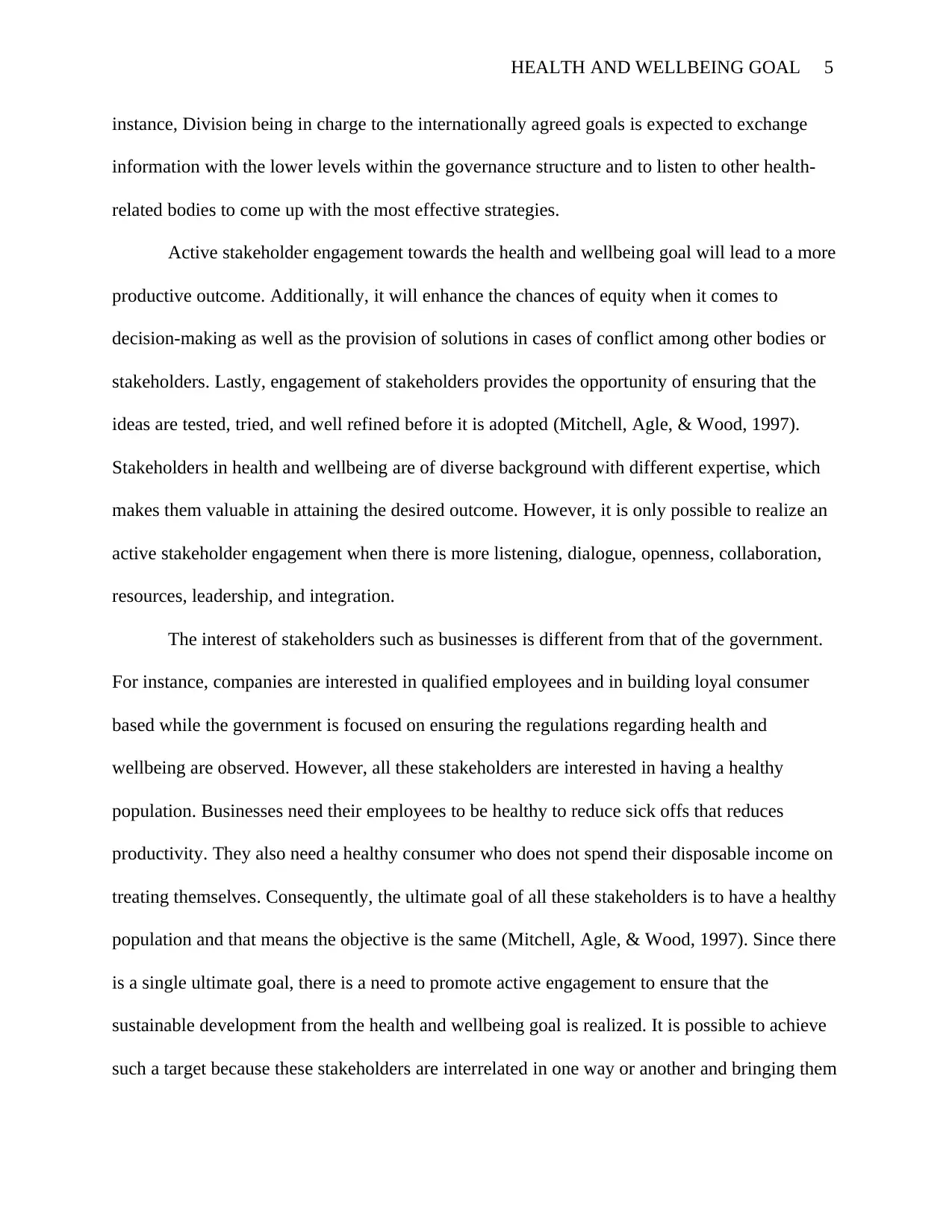
HEALTH AND WELLBEING GOAL 5
instance, Division being in charge to the internationally agreed goals is expected to exchange
information with the lower levels within the governance structure and to listen to other health-
related bodies to come up with the most effective strategies.
Active stakeholder engagement towards the health and wellbeing goal will lead to a more
productive outcome. Additionally, it will enhance the chances of equity when it comes to
decision-making as well as the provision of solutions in cases of conflict among other bodies or
stakeholders. Lastly, engagement of stakeholders provides the opportunity of ensuring that the
ideas are tested, tried, and well refined before it is adopted (Mitchell, Agle, & Wood, 1997).
Stakeholders in health and wellbeing are of diverse background with different expertise, which
makes them valuable in attaining the desired outcome. However, it is only possible to realize an
active stakeholder engagement when there is more listening, dialogue, openness, collaboration,
resources, leadership, and integration.
The interest of stakeholders such as businesses is different from that of the government.
For instance, companies are interested in qualified employees and in building loyal consumer
based while the government is focused on ensuring the regulations regarding health and
wellbeing are observed. However, all these stakeholders are interested in having a healthy
population. Businesses need their employees to be healthy to reduce sick offs that reduces
productivity. They also need a healthy consumer who does not spend their disposable income on
treating themselves. Consequently, the ultimate goal of all these stakeholders is to have a healthy
population and that means the objective is the same (Mitchell, Agle, & Wood, 1997). Since there
is a single ultimate goal, there is a need to promote active engagement to ensure that the
sustainable development from the health and wellbeing goal is realized. It is possible to achieve
such a target because these stakeholders are interrelated in one way or another and bringing them
instance, Division being in charge to the internationally agreed goals is expected to exchange
information with the lower levels within the governance structure and to listen to other health-
related bodies to come up with the most effective strategies.
Active stakeholder engagement towards the health and wellbeing goal will lead to a more
productive outcome. Additionally, it will enhance the chances of equity when it comes to
decision-making as well as the provision of solutions in cases of conflict among other bodies or
stakeholders. Lastly, engagement of stakeholders provides the opportunity of ensuring that the
ideas are tested, tried, and well refined before it is adopted (Mitchell, Agle, & Wood, 1997).
Stakeholders in health and wellbeing are of diverse background with different expertise, which
makes them valuable in attaining the desired outcome. However, it is only possible to realize an
active stakeholder engagement when there is more listening, dialogue, openness, collaboration,
resources, leadership, and integration.
The interest of stakeholders such as businesses is different from that of the government.
For instance, companies are interested in qualified employees and in building loyal consumer
based while the government is focused on ensuring the regulations regarding health and
wellbeing are observed. However, all these stakeholders are interested in having a healthy
population. Businesses need their employees to be healthy to reduce sick offs that reduces
productivity. They also need a healthy consumer who does not spend their disposable income on
treating themselves. Consequently, the ultimate goal of all these stakeholders is to have a healthy
population and that means the objective is the same (Mitchell, Agle, & Wood, 1997). Since there
is a single ultimate goal, there is a need to promote active engagement to ensure that the
sustainable development from the health and wellbeing goal is realized. It is possible to achieve
such a target because these stakeholders are interrelated in one way or another and bringing them
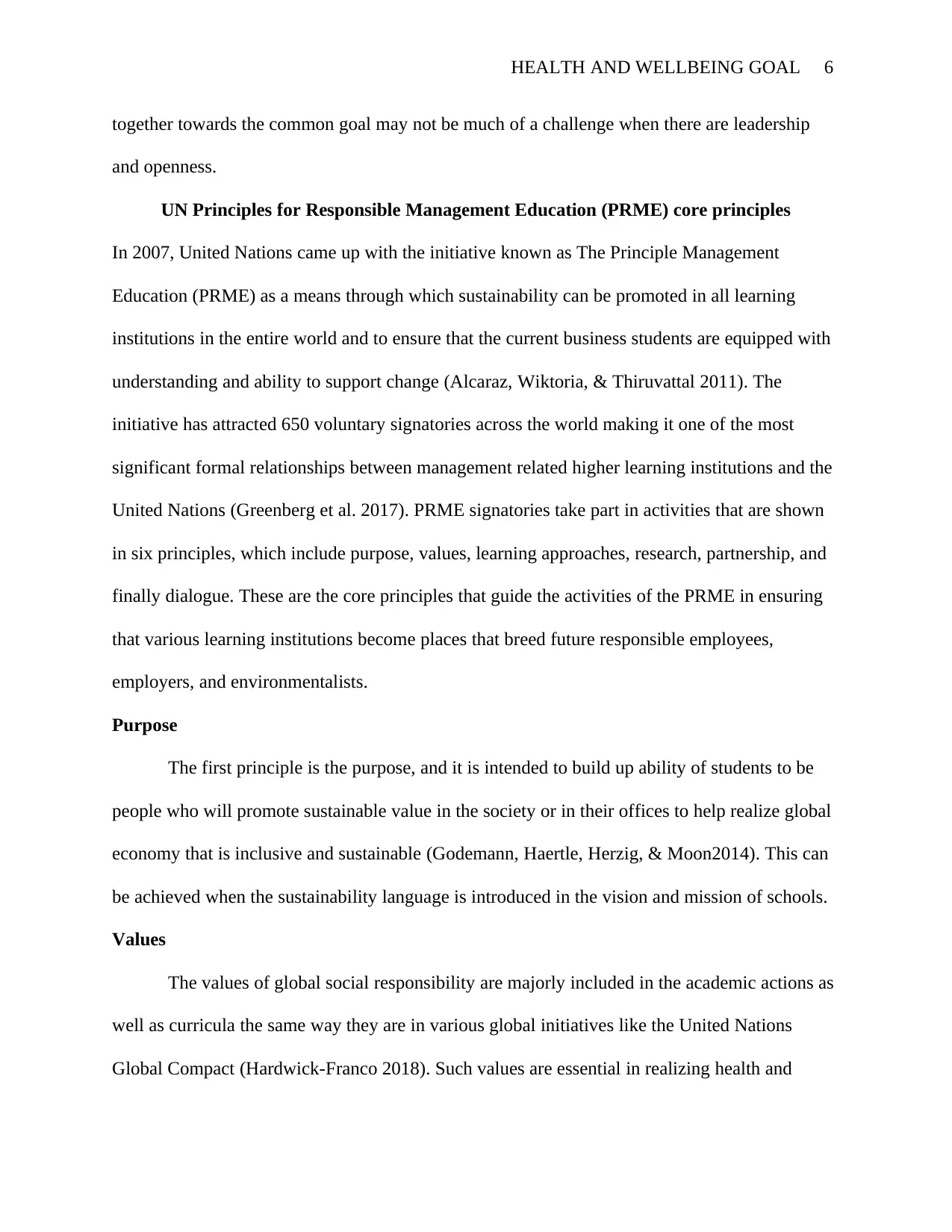
HEALTH AND WELLBEING GOAL 6
together towards the common goal may not be much of a challenge when there are leadership
and openness.
UN Principles for Responsible Management Education (PRME) core principles
In 2007, United Nations came up with the initiative known as The Principle Management
Education (PRME) as a means through which sustainability can be promoted in all learning
institutions in the entire world and to ensure that the current business students are equipped with
understanding and ability to support change (Alcaraz, Wiktoria, & Thiruvattal 2011). The
initiative has attracted 650 voluntary signatories across the world making it one of the most
significant formal relationships between management related higher learning institutions and the
United Nations (Greenberg et al. 2017). PRME signatories take part in activities that are shown
in six principles, which include purpose, values, learning approaches, research, partnership, and
finally dialogue. These are the core principles that guide the activities of the PRME in ensuring
that various learning institutions become places that breed future responsible employees,
employers, and environmentalists.
Purpose
The first principle is the purpose, and it is intended to build up ability of students to be
people who will promote sustainable value in the society or in their offices to help realize global
economy that is inclusive and sustainable (Godemann, Haertle, Herzig, & Moon2014). This can
be achieved when the sustainability language is introduced in the vision and mission of schools.
Values
The values of global social responsibility are majorly included in the academic actions as
well as curricula the same way they are in various global initiatives like the United Nations
Global Compact (Hardwick-Franco 2018). Such values are essential in realizing health and
together towards the common goal may not be much of a challenge when there are leadership
and openness.
UN Principles for Responsible Management Education (PRME) core principles
In 2007, United Nations came up with the initiative known as The Principle Management
Education (PRME) as a means through which sustainability can be promoted in all learning
institutions in the entire world and to ensure that the current business students are equipped with
understanding and ability to support change (Alcaraz, Wiktoria, & Thiruvattal 2011). The
initiative has attracted 650 voluntary signatories across the world making it one of the most
significant formal relationships between management related higher learning institutions and the
United Nations (Greenberg et al. 2017). PRME signatories take part in activities that are shown
in six principles, which include purpose, values, learning approaches, research, partnership, and
finally dialogue. These are the core principles that guide the activities of the PRME in ensuring
that various learning institutions become places that breed future responsible employees,
employers, and environmentalists.
Purpose
The first principle is the purpose, and it is intended to build up ability of students to be
people who will promote sustainable value in the society or in their offices to help realize global
economy that is inclusive and sustainable (Godemann, Haertle, Herzig, & Moon2014). This can
be achieved when the sustainability language is introduced in the vision and mission of schools.
Values
The values of global social responsibility are majorly included in the academic actions as
well as curricula the same way they are in various global initiatives like the United Nations
Global Compact (Hardwick-Franco 2018). Such values are essential in realizing health and
⊘ This is a preview!⊘
Do you want full access?
Subscribe today to unlock all pages.

Trusted by 1+ million students worldwide
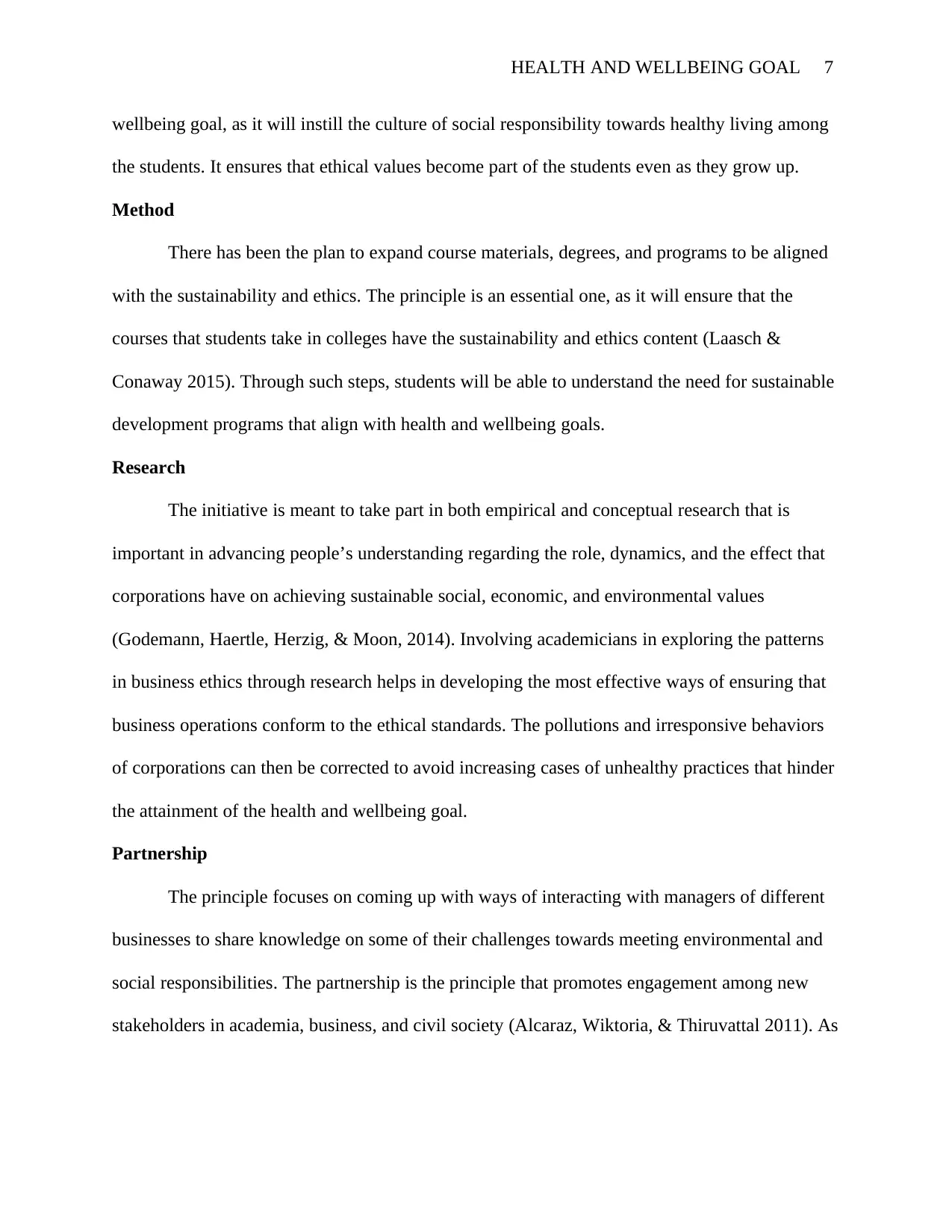
HEALTH AND WELLBEING GOAL 7
wellbeing goal, as it will instill the culture of social responsibility towards healthy living among
the students. It ensures that ethical values become part of the students even as they grow up.
Method
There has been the plan to expand course materials, degrees, and programs to be aligned
with the sustainability and ethics. The principle is an essential one, as it will ensure that the
courses that students take in colleges have the sustainability and ethics content (Laasch &
Conaway 2015). Through such steps, students will be able to understand the need for sustainable
development programs that align with health and wellbeing goals.
Research
The initiative is meant to take part in both empirical and conceptual research that is
important in advancing people’s understanding regarding the role, dynamics, and the effect that
corporations have on achieving sustainable social, economic, and environmental values
(Godemann, Haertle, Herzig, & Moon, 2014). Involving academicians in exploring the patterns
in business ethics through research helps in developing the most effective ways of ensuring that
business operations conform to the ethical standards. The pollutions and irresponsive behaviors
of corporations can then be corrected to avoid increasing cases of unhealthy practices that hinder
the attainment of the health and wellbeing goal.
Partnership
The principle focuses on coming up with ways of interacting with managers of different
businesses to share knowledge on some of their challenges towards meeting environmental and
social responsibilities. The partnership is the principle that promotes engagement among new
stakeholders in academia, business, and civil society (Alcaraz, Wiktoria, & Thiruvattal 2011). As
wellbeing goal, as it will instill the culture of social responsibility towards healthy living among
the students. It ensures that ethical values become part of the students even as they grow up.
Method
There has been the plan to expand course materials, degrees, and programs to be aligned
with the sustainability and ethics. The principle is an essential one, as it will ensure that the
courses that students take in colleges have the sustainability and ethics content (Laasch &
Conaway 2015). Through such steps, students will be able to understand the need for sustainable
development programs that align with health and wellbeing goals.
Research
The initiative is meant to take part in both empirical and conceptual research that is
important in advancing people’s understanding regarding the role, dynamics, and the effect that
corporations have on achieving sustainable social, economic, and environmental values
(Godemann, Haertle, Herzig, & Moon, 2014). Involving academicians in exploring the patterns
in business ethics through research helps in developing the most effective ways of ensuring that
business operations conform to the ethical standards. The pollutions and irresponsive behaviors
of corporations can then be corrected to avoid increasing cases of unhealthy practices that hinder
the attainment of the health and wellbeing goal.
Partnership
The principle focuses on coming up with ways of interacting with managers of different
businesses to share knowledge on some of their challenges towards meeting environmental and
social responsibilities. The partnership is the principle that promotes engagement among new
stakeholders in academia, business, and civil society (Alcaraz, Wiktoria, & Thiruvattal 2011). As
Paraphrase This Document
Need a fresh take? Get an instant paraphrase of this document with our AI Paraphraser
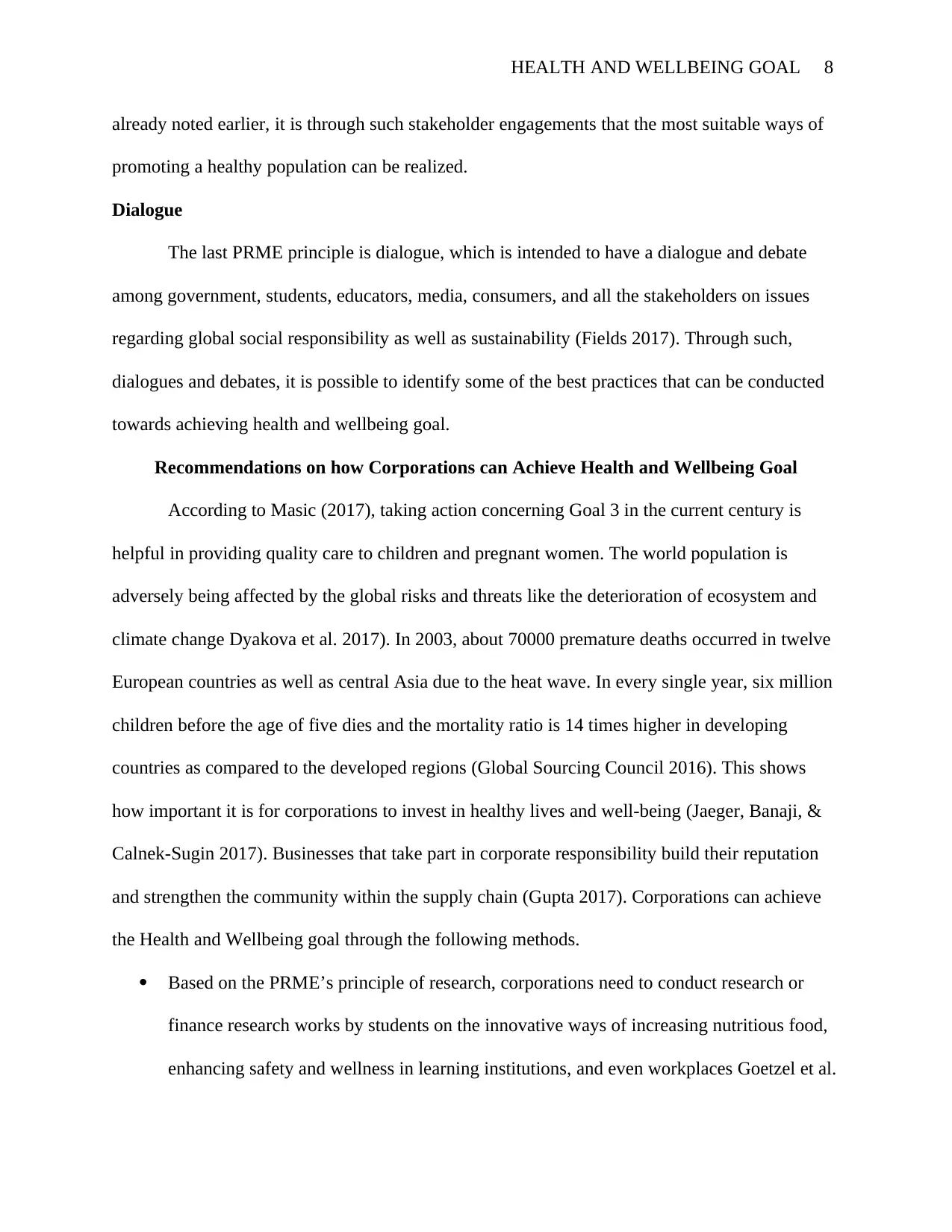
HEALTH AND WELLBEING GOAL 8
already noted earlier, it is through such stakeholder engagements that the most suitable ways of
promoting a healthy population can be realized.
Dialogue
The last PRME principle is dialogue, which is intended to have a dialogue and debate
among government, students, educators, media, consumers, and all the stakeholders on issues
regarding global social responsibility as well as sustainability (Fields 2017). Through such,
dialogues and debates, it is possible to identify some of the best practices that can be conducted
towards achieving health and wellbeing goal.
Recommendations on how Corporations can Achieve Health and Wellbeing Goal
According to Masic (2017), taking action concerning Goal 3 in the current century is
helpful in providing quality care to children and pregnant women. The world population is
adversely being affected by the global risks and threats like the deterioration of ecosystem and
climate change Dyakova et al. 2017). In 2003, about 70000 premature deaths occurred in twelve
European countries as well as central Asia due to the heat wave. In every single year, six million
children before the age of five dies and the mortality ratio is 14 times higher in developing
countries as compared to the developed regions (Global Sourcing Council 2016). This shows
how important it is for corporations to invest in healthy lives and well-being (Jaeger, Banaji, &
Calnek-Sugin 2017). Businesses that take part in corporate responsibility build their reputation
and strengthen the community within the supply chain (Gupta 2017). Corporations can achieve
the Health and Wellbeing goal through the following methods.
Based on the PRME’s principle of research, corporations need to conduct research or
finance research works by students on the innovative ways of increasing nutritious food,
enhancing safety and wellness in learning institutions, and even workplaces Goetzel et al.
already noted earlier, it is through such stakeholder engagements that the most suitable ways of
promoting a healthy population can be realized.
Dialogue
The last PRME principle is dialogue, which is intended to have a dialogue and debate
among government, students, educators, media, consumers, and all the stakeholders on issues
regarding global social responsibility as well as sustainability (Fields 2017). Through such,
dialogues and debates, it is possible to identify some of the best practices that can be conducted
towards achieving health and wellbeing goal.
Recommendations on how Corporations can Achieve Health and Wellbeing Goal
According to Masic (2017), taking action concerning Goal 3 in the current century is
helpful in providing quality care to children and pregnant women. The world population is
adversely being affected by the global risks and threats like the deterioration of ecosystem and
climate change Dyakova et al. 2017). In 2003, about 70000 premature deaths occurred in twelve
European countries as well as central Asia due to the heat wave. In every single year, six million
children before the age of five dies and the mortality ratio is 14 times higher in developing
countries as compared to the developed regions (Global Sourcing Council 2016). This shows
how important it is for corporations to invest in healthy lives and well-being (Jaeger, Banaji, &
Calnek-Sugin 2017). Businesses that take part in corporate responsibility build their reputation
and strengthen the community within the supply chain (Gupta 2017). Corporations can achieve
the Health and Wellbeing goal through the following methods.
Based on the PRME’s principle of research, corporations need to conduct research or
finance research works by students on the innovative ways of increasing nutritious food,
enhancing safety and wellness in learning institutions, and even workplaces Goetzel et al.
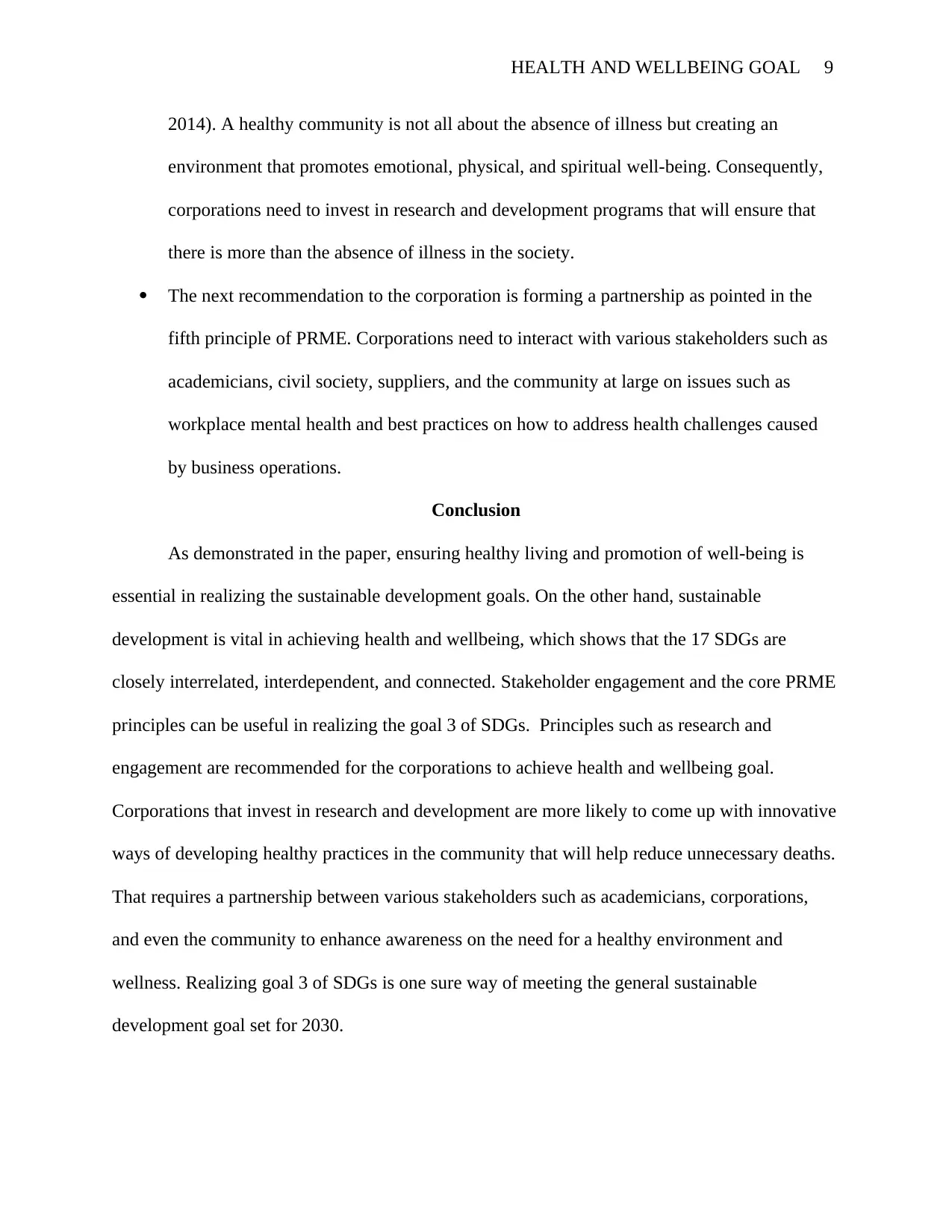
HEALTH AND WELLBEING GOAL 9
2014). A healthy community is not all about the absence of illness but creating an
environment that promotes emotional, physical, and spiritual well-being. Consequently,
corporations need to invest in research and development programs that will ensure that
there is more than the absence of illness in the society.
The next recommendation to the corporation is forming a partnership as pointed in the
fifth principle of PRME. Corporations need to interact with various stakeholders such as
academicians, civil society, suppliers, and the community at large on issues such as
workplace mental health and best practices on how to address health challenges caused
by business operations.
Conclusion
As demonstrated in the paper, ensuring healthy living and promotion of well-being is
essential in realizing the sustainable development goals. On the other hand, sustainable
development is vital in achieving health and wellbeing, which shows that the 17 SDGs are
closely interrelated, interdependent, and connected. Stakeholder engagement and the core PRME
principles can be useful in realizing the goal 3 of SDGs. Principles such as research and
engagement are recommended for the corporations to achieve health and wellbeing goal.
Corporations that invest in research and development are more likely to come up with innovative
ways of developing healthy practices in the community that will help reduce unnecessary deaths.
That requires a partnership between various stakeholders such as academicians, corporations,
and even the community to enhance awareness on the need for a healthy environment and
wellness. Realizing goal 3 of SDGs is one sure way of meeting the general sustainable
development goal set for 2030.
2014). A healthy community is not all about the absence of illness but creating an
environment that promotes emotional, physical, and spiritual well-being. Consequently,
corporations need to invest in research and development programs that will ensure that
there is more than the absence of illness in the society.
The next recommendation to the corporation is forming a partnership as pointed in the
fifth principle of PRME. Corporations need to interact with various stakeholders such as
academicians, civil society, suppliers, and the community at large on issues such as
workplace mental health and best practices on how to address health challenges caused
by business operations.
Conclusion
As demonstrated in the paper, ensuring healthy living and promotion of well-being is
essential in realizing the sustainable development goals. On the other hand, sustainable
development is vital in achieving health and wellbeing, which shows that the 17 SDGs are
closely interrelated, interdependent, and connected. Stakeholder engagement and the core PRME
principles can be useful in realizing the goal 3 of SDGs. Principles such as research and
engagement are recommended for the corporations to achieve health and wellbeing goal.
Corporations that invest in research and development are more likely to come up with innovative
ways of developing healthy practices in the community that will help reduce unnecessary deaths.
That requires a partnership between various stakeholders such as academicians, corporations,
and even the community to enhance awareness on the need for a healthy environment and
wellness. Realizing goal 3 of SDGs is one sure way of meeting the general sustainable
development goal set for 2030.
⊘ This is a preview!⊘
Do you want full access?
Subscribe today to unlock all pages.

Trusted by 1+ million students worldwide
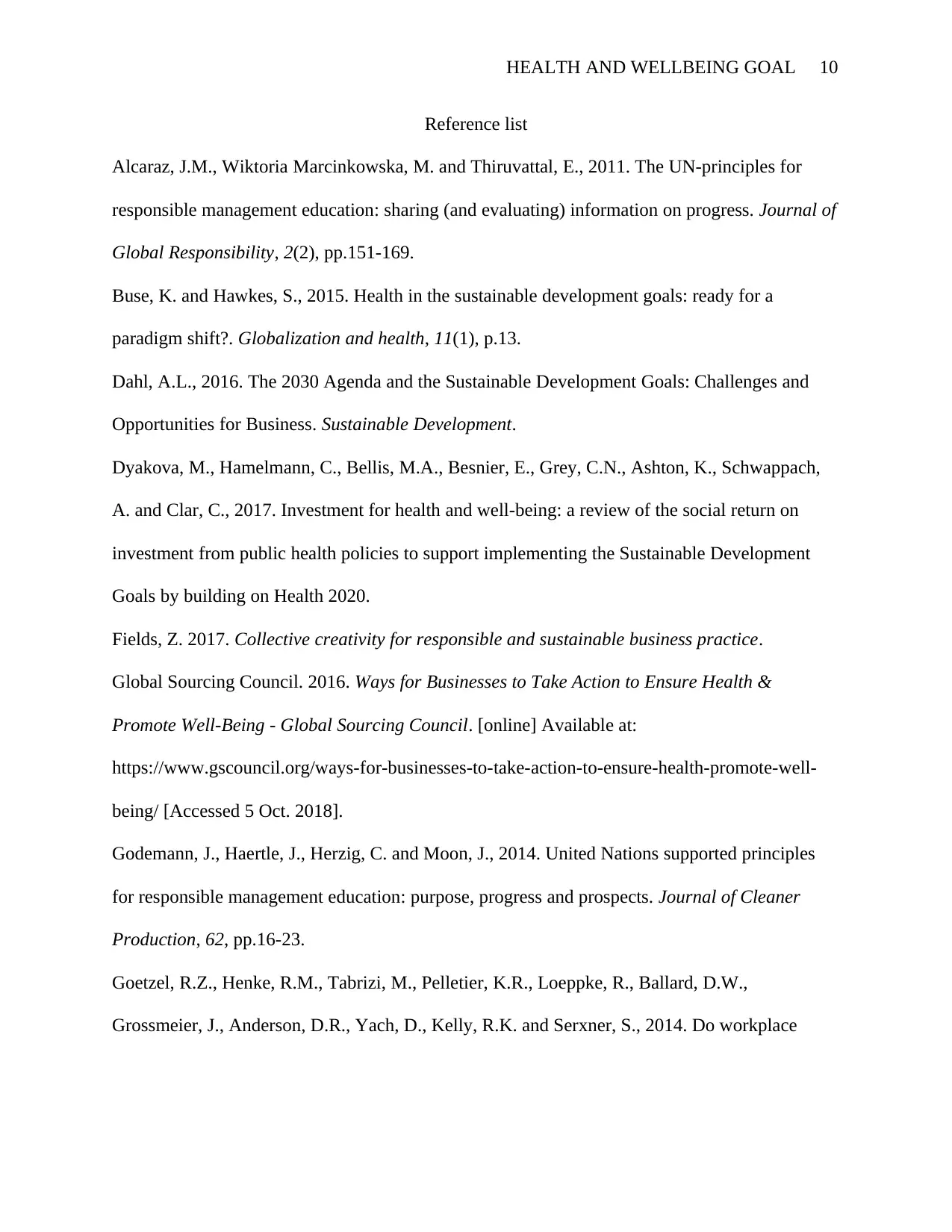
HEALTH AND WELLBEING GOAL 10
Reference list
Alcaraz, J.M., Wiktoria Marcinkowska, M. and Thiruvattal, E., 2011. The UN-principles for
responsible management education: sharing (and evaluating) information on progress. Journal of
Global Responsibility, 2(2), pp.151-169.
Buse, K. and Hawkes, S., 2015. Health in the sustainable development goals: ready for a
paradigm shift?. Globalization and health, 11(1), p.13.
Dahl, A.L., 2016. The 2030 Agenda and the Sustainable Development Goals: Challenges and
Opportunities for Business. Sustainable Development.
Dyakova, M., Hamelmann, C., Bellis, M.A., Besnier, E., Grey, C.N., Ashton, K., Schwappach,
A. and Clar, C., 2017. Investment for health and well-being: a review of the social return on
investment from public health policies to support implementing the Sustainable Development
Goals by building on Health 2020.
Fields, Z. 2017. Collective creativity for responsible and sustainable business practice.
Global Sourcing Council. 2016. Ways for Businesses to Take Action to Ensure Health &
Promote Well-Being - Global Sourcing Council. [online] Available at:
https://www.gscouncil.org/ways-for-businesses-to-take-action-to-ensure-health-promote-well-
being/ [Accessed 5 Oct. 2018].
Godemann, J., Haertle, J., Herzig, C. and Moon, J., 2014. United Nations supported principles
for responsible management education: purpose, progress and prospects. Journal of Cleaner
Production, 62, pp.16-23.
Goetzel, R.Z., Henke, R.M., Tabrizi, M., Pelletier, K.R., Loeppke, R., Ballard, D.W.,
Grossmeier, J., Anderson, D.R., Yach, D., Kelly, R.K. and Serxner, S., 2014. Do workplace
Reference list
Alcaraz, J.M., Wiktoria Marcinkowska, M. and Thiruvattal, E., 2011. The UN-principles for
responsible management education: sharing (and evaluating) information on progress. Journal of
Global Responsibility, 2(2), pp.151-169.
Buse, K. and Hawkes, S., 2015. Health in the sustainable development goals: ready for a
paradigm shift?. Globalization and health, 11(1), p.13.
Dahl, A.L., 2016. The 2030 Agenda and the Sustainable Development Goals: Challenges and
Opportunities for Business. Sustainable Development.
Dyakova, M., Hamelmann, C., Bellis, M.A., Besnier, E., Grey, C.N., Ashton, K., Schwappach,
A. and Clar, C., 2017. Investment for health and well-being: a review of the social return on
investment from public health policies to support implementing the Sustainable Development
Goals by building on Health 2020.
Fields, Z. 2017. Collective creativity for responsible and sustainable business practice.
Global Sourcing Council. 2016. Ways for Businesses to Take Action to Ensure Health &
Promote Well-Being - Global Sourcing Council. [online] Available at:
https://www.gscouncil.org/ways-for-businesses-to-take-action-to-ensure-health-promote-well-
being/ [Accessed 5 Oct. 2018].
Godemann, J., Haertle, J., Herzig, C. and Moon, J., 2014. United Nations supported principles
for responsible management education: purpose, progress and prospects. Journal of Cleaner
Production, 62, pp.16-23.
Goetzel, R.Z., Henke, R.M., Tabrizi, M., Pelletier, K.R., Loeppke, R., Ballard, D.W.,
Grossmeier, J., Anderson, D.R., Yach, D., Kelly, R.K. and Serxner, S., 2014. Do workplace
Paraphrase This Document
Need a fresh take? Get an instant paraphrase of this document with our AI Paraphraser
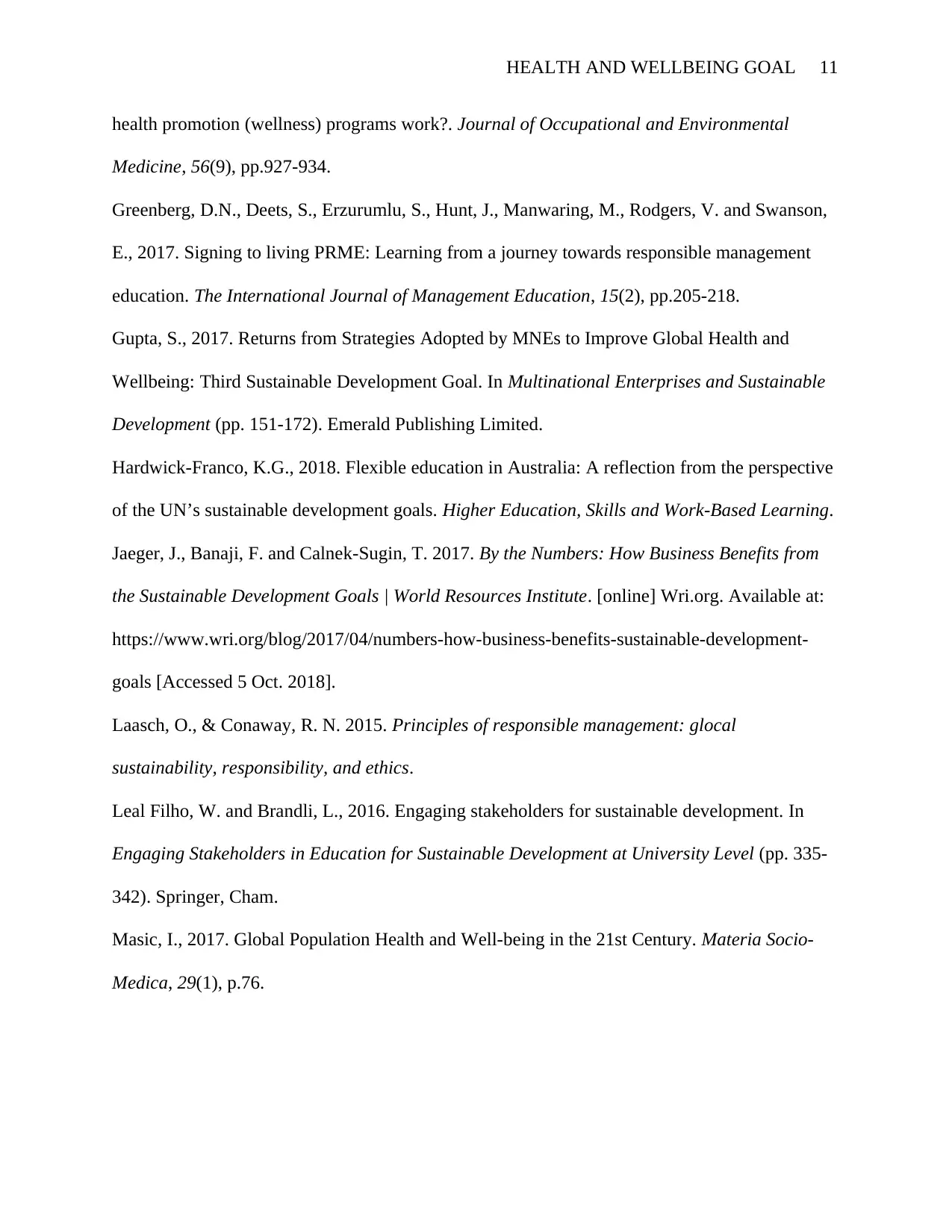
HEALTH AND WELLBEING GOAL 11
health promotion (wellness) programs work?. Journal of Occupational and Environmental
Medicine, 56(9), pp.927-934.
Greenberg, D.N., Deets, S., Erzurumlu, S., Hunt, J., Manwaring, M., Rodgers, V. and Swanson,
E., 2017. Signing to living PRME: Learning from a journey towards responsible management
education. The International Journal of Management Education, 15(2), pp.205-218.
Gupta, S., 2017. Returns from Strategies Adopted by MNEs to Improve Global Health and
Wellbeing: Third Sustainable Development Goal. In Multinational Enterprises and Sustainable
Development (pp. 151-172). Emerald Publishing Limited.
Hardwick-Franco, K.G., 2018. Flexible education in Australia: A reflection from the perspective
of the UN’s sustainable development goals. Higher Education, Skills and Work-Based Learning.
Jaeger, J., Banaji, F. and Calnek-Sugin, T. 2017. By the Numbers: How Business Benefits from
the Sustainable Development Goals | World Resources Institute. [online] Wri.org. Available at:
https://www.wri.org/blog/2017/04/numbers-how-business-benefits-sustainable-development-
goals [Accessed 5 Oct. 2018].
Laasch, O., & Conaway, R. N. 2015. Principles of responsible management: glocal
sustainability, responsibility, and ethics.
Leal Filho, W. and Brandli, L., 2016. Engaging stakeholders for sustainable development. In
Engaging Stakeholders in Education for Sustainable Development at University Level (pp. 335-
342). Springer, Cham.
Masic, I., 2017. Global Population Health and Well-being in the 21st Century. Materia Socio-
Medica, 29(1), p.76.
health promotion (wellness) programs work?. Journal of Occupational and Environmental
Medicine, 56(9), pp.927-934.
Greenberg, D.N., Deets, S., Erzurumlu, S., Hunt, J., Manwaring, M., Rodgers, V. and Swanson,
E., 2017. Signing to living PRME: Learning from a journey towards responsible management
education. The International Journal of Management Education, 15(2), pp.205-218.
Gupta, S., 2017. Returns from Strategies Adopted by MNEs to Improve Global Health and
Wellbeing: Third Sustainable Development Goal. In Multinational Enterprises and Sustainable
Development (pp. 151-172). Emerald Publishing Limited.
Hardwick-Franco, K.G., 2018. Flexible education in Australia: A reflection from the perspective
of the UN’s sustainable development goals. Higher Education, Skills and Work-Based Learning.
Jaeger, J., Banaji, F. and Calnek-Sugin, T. 2017. By the Numbers: How Business Benefits from
the Sustainable Development Goals | World Resources Institute. [online] Wri.org. Available at:
https://www.wri.org/blog/2017/04/numbers-how-business-benefits-sustainable-development-
goals [Accessed 5 Oct. 2018].
Laasch, O., & Conaway, R. N. 2015. Principles of responsible management: glocal
sustainability, responsibility, and ethics.
Leal Filho, W. and Brandli, L., 2016. Engaging stakeholders for sustainable development. In
Engaging Stakeholders in Education for Sustainable Development at University Level (pp. 335-
342). Springer, Cham.
Masic, I., 2017. Global Population Health and Well-being in the 21st Century. Materia Socio-
Medica, 29(1), p.76.
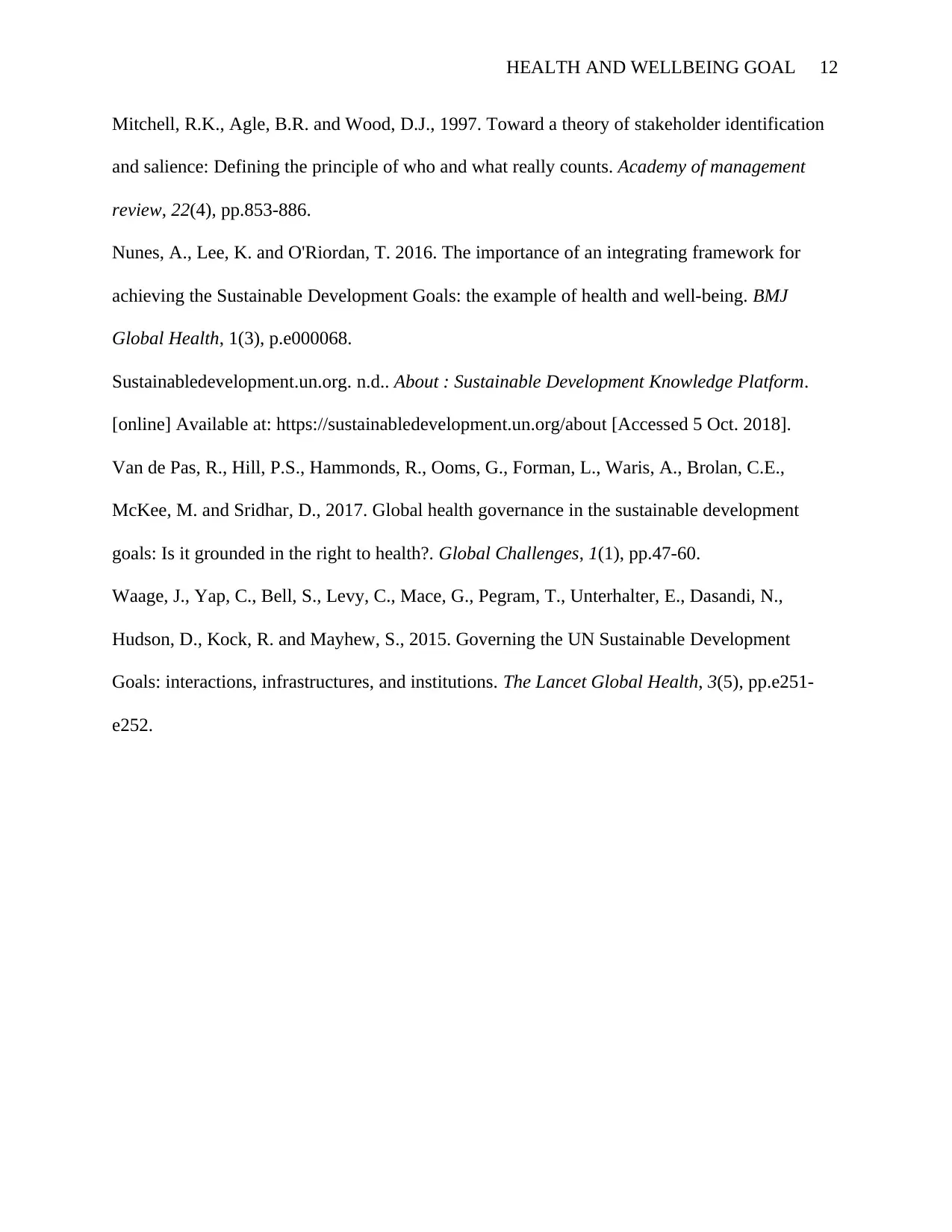
HEALTH AND WELLBEING GOAL 12
Mitchell, R.K., Agle, B.R. and Wood, D.J., 1997. Toward a theory of stakeholder identification
and salience: Defining the principle of who and what really counts. Academy of management
review, 22(4), pp.853-886.
Nunes, A., Lee, K. and O'Riordan, T. 2016. The importance of an integrating framework for
achieving the Sustainable Development Goals: the example of health and well-being. BMJ
Global Health, 1(3), p.e000068.
Sustainabledevelopment.un.org. n.d.. About : Sustainable Development Knowledge Platform.
[online] Available at: https://sustainabledevelopment.un.org/about [Accessed 5 Oct. 2018].
Van de Pas, R., Hill, P.S., Hammonds, R., Ooms, G., Forman, L., Waris, A., Brolan, C.E.,
McKee, M. and Sridhar, D., 2017. Global health governance in the sustainable development
goals: Is it grounded in the right to health?. Global Challenges, 1(1), pp.47-60.
Waage, J., Yap, C., Bell, S., Levy, C., Mace, G., Pegram, T., Unterhalter, E., Dasandi, N.,
Hudson, D., Kock, R. and Mayhew, S., 2015. Governing the UN Sustainable Development
Goals: interactions, infrastructures, and institutions. The Lancet Global Health, 3(5), pp.e251-
e252.
Mitchell, R.K., Agle, B.R. and Wood, D.J., 1997. Toward a theory of stakeholder identification
and salience: Defining the principle of who and what really counts. Academy of management
review, 22(4), pp.853-886.
Nunes, A., Lee, K. and O'Riordan, T. 2016. The importance of an integrating framework for
achieving the Sustainable Development Goals: the example of health and well-being. BMJ
Global Health, 1(3), p.e000068.
Sustainabledevelopment.un.org. n.d.. About : Sustainable Development Knowledge Platform.
[online] Available at: https://sustainabledevelopment.un.org/about [Accessed 5 Oct. 2018].
Van de Pas, R., Hill, P.S., Hammonds, R., Ooms, G., Forman, L., Waris, A., Brolan, C.E.,
McKee, M. and Sridhar, D., 2017. Global health governance in the sustainable development
goals: Is it grounded in the right to health?. Global Challenges, 1(1), pp.47-60.
Waage, J., Yap, C., Bell, S., Levy, C., Mace, G., Pegram, T., Unterhalter, E., Dasandi, N.,
Hudson, D., Kock, R. and Mayhew, S., 2015. Governing the UN Sustainable Development
Goals: interactions, infrastructures, and institutions. The Lancet Global Health, 3(5), pp.e251-
e252.
⊘ This is a preview!⊘
Do you want full access?
Subscribe today to unlock all pages.

Trusted by 1+ million students worldwide
1 out of 12
Related Documents
Your All-in-One AI-Powered Toolkit for Academic Success.
+13062052269
info@desklib.com
Available 24*7 on WhatsApp / Email
![[object Object]](/_next/static/media/star-bottom.7253800d.svg)
Unlock your academic potential
Copyright © 2020–2025 A2Z Services. All Rights Reserved. Developed and managed by ZUCOL.




